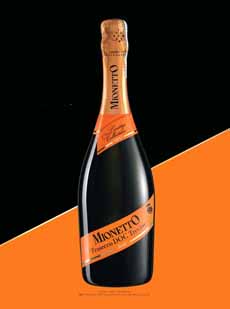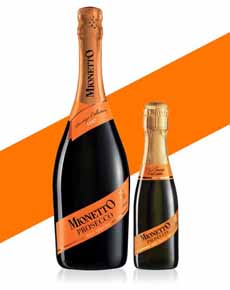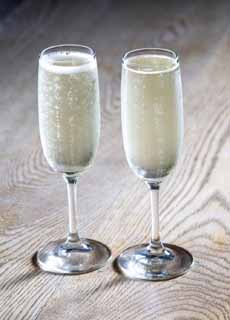TIP OF THE DAY: Mionetto Prosecco For Halloween
 [1] Ready for Halloween drinking or gifting. This is the traditional bottle shape for all Proseccos (photos #1 and #2 courtesy Mionetto).
|
Are you planning a Halloween party? Will you be a guest at one? Are you staying home to greet the trick-or-treaters (or hide from them)? In any case, you deserve your own treat: Mionetto prosecco. Its black-and-orange colors are holiday-themed, and the sparkling wine inside is delicious for drinking straight or turning into cocktails: How about some Prosecco Ice Pops? Prosecco is a very affordable bubbly that often takes the place of Champagne at the table—or the party. Prosecco (pro-SEK-o) is the name of a village in northeast Italy’s Veneto region. It is located in the hills of the province of Treviso, between the towns of Conegliano and Valdobbiadene. It’s the of home Prosecco sparkling wines. In Europe, wines are named after the place where the grapes are grown and the wine is made. The wine is often labeled Prosecco di Conegliano Valdobbiadene, after its appellation*. The Prosecco grape—now known as the Glera grape—originated there. While most of the wines are largely Glera, by law other local white grape varieties, such as Bianchetta Trevigiana, can be included in the blend. The second fermentation† takes place in a stainless steel tank and the resulting wine is bottled under pressure. This is a much less expensive way to do the job, and wines made by this method are less expensive than traditional method bubblies that follow the Champagne style. The history of Prosecco is not well documented. Until recently, there were different theories about its origin. Now, it is believed that the first Prosecco was created in 1868 by Antonio Carpene, who subjected still white wine of the area to a second fermentation, which produced the bubbles. In general, the wine of Prosecco has been linked to a wine made at the time of Roman Empire, in a town called Pucino. It, like Prosecco, was located in the hills that surround the Gulf of Trieste [source]. (The town no longer exists, but the surname Pucino, indicating a person from Pucino, is still going strong.) Using grape DNA and archaeological evidence, it was more recently established that the grape called Prosecco was very similar to the older grape from the Pucino area, Glera. The grape called Prosecco is now called Glera. |
|
|
________________ *An appellation is a legally defined and protected geographical indication, used to identify where the grapes for a wine were grown. Restrictions other than geographical boundaries, such as what grapes may be grown, maximum grape yields, alcohol level, and other quality factors, may also apply before an appellation name may legally appear on a wine bottle label. The rules that govern appellations are dependent on the country in which the wine was produced, and a legal designation appears on the label. A.O.C., Appellation d’Origine Contrôlée (the appellation of origin is controlled by law) is one of these. The tradition of wine appellation is ancient: References are found in the Bible, where the wines of Carmel, Samaria, Helbon and Jezreel are mentioned. The tradition of appellation continued throughout antiquity and the Middle Ages, though without any of the legally sanctioned rules as exist in modern times (see paragraph above). Historically, the world’s first exclusive (protected) vineyard zone was introduced in Chianti, Italy in 1716; and the first wine classification system in Tokaj-Hegyalja, Hungary, in 1730 [source]. Other types of food often have appellations as well. Products from certain highly-regarded apples to cheeses to figs to walnuts are A.O.C. designations (here’s more). A.O.C. guarantees quality and authenticity to the consumer. †Sparkling wines undergo two fermentations. The second fermentation creates the bubbles. |
||




